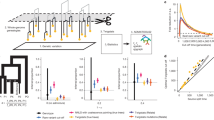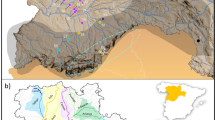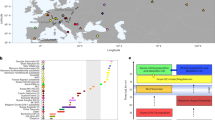Abstract
Three coalescent-based methods allowed us to infer some aspects of the history of three Bulgarian Gypsies populations belonging to the Vlax linguistic group: the Lom, Rudari and Kalderas. We used several kinds of genetic markers: HV1 sequences of the maternally inherited mitochondrial genome and microsatellites of the paternally inherited Y chromosome and of the biparentally inherited chromosome 8. This allowed us to infer several parameters for men and women: the splitting order of the populations and the ages of the splitting events, the growth rate in each population and the migration rates between populations. Altogether, they enabled us to infer a demographic scenario that could explain the genetic diversity of Vlax Roma: recent splits occurring after the arrival in Europe, asymmetric migration flows especially for males and unequal growth rates. This represents a considerable contribution to the Vlax Roma history in comparison with the inferences from classical population genetics.
Similar content being viewed by others
Log in or create a free account to read this content
Gain free access to this article, as well as selected content from this journal and more on nature.com
or
References
Fraser A : The Gypsies. Oxford: Blackwell Publishers; 1992.
Liégeois J-P : Roma, Gypsies, Travellers. Strasbourg: Council of Europe Press; 1994.
Gresham D, Morar B, Underhill PA et al: Origins and divergence of the Roma (Gypsies). Am J Hum Genet 2001; 69: 1314–1331.
Kalaydjieva L, Hallmayer J, Chandler D et al: Gene mapping in Gypsies identifies a novel demyelinating neuropathy on chromosome 8q24. Nat Genet 1996; 14: 214–217.
Kalaydjieva L, Gresham D, Gooding R et al: N-myc downstream-regulated gene 1 is mutated in hereditary motor and sensory neuropathy-Lom. Am J Hum Genet 2000; 67: 47–58.
Rogers T, Chandler D, Angelicheva D et al: A novel locus for autosomal recessive peripheral neuropathy in the EGR2 region on 10q23. Am J Hum Genet 2000; 67: 664–671.
Hantke J, Rogers T, French L et al: Refined mapping of the HMSNR critical gene region – construction of a high-density integrated genetic and physical map. Neuromusc Disord 2003; 13 (9): 729–736.
Angelicheva D, Turnev I, Dye D et al: Congenital cataracts facial dysmorphism neuropathy (CCFDN) syndrome: a novel developmental disorder in Gypsies maps to 18qter. Eur J Hum Genet 1999; 7: 560–566.
Merlini L, Gooding R, Lochmueller W et al: Genetic identity of Marinesco-Sjogren/ myoglobinuria and CCFDN syndromes. Neurology 2002; 58: 231–236.
Kalaydjieva L, Perez-Lezaun A, Angelicheva D et al: A founder mutation in the GK1 gene is responsible for galactokinase deficiency in Roma (Gypsies). Am J Hum Genet 1999; 65: 1299–1307.
Hunter M, Heyer E, Austerlitz F et al: The P28T mutation in the GALK1 gene accounts for galactokinase deficiency in Roma (Gypsy) patients across Europe. Pediatr Res 2002; 51: 602–606.
Kalaydjieva L, Calafell F, Jobling MA et al: Patterns of inter- and intra-group genetic diversity in the Vlax Roma as revealed by Y chromosome and mitochondrial DNA lineages. Eur J Hum Genet 2001; 9: 97–104.
Hey J, Machado CA : The study of structured populations – new hope for a difficult and divided science. Nat Rev Genet 2003; 4: 535–543.
Beerli P, Felsenstein J : Maximum-likelihood estimation of migration rates and effective population numbers in two populations using a coalescent approach. Genetics 1999; 152: 763–773.
Beerli P, Felsenstein J : Maximum likelihood estimation of a migration matrix and effective population sizes in n subpopulations by using a coalescent approach. Proc Natl Acad Sci USA 2001; 98: 4563–4568.
Kuhner MK, Yamato J, Felsenstein J : Estimating effective population size and mutation rate from sequence data using Metropolis–Hastings sampling. Genetics 1995; 140: 1421–1430.
Kuhner MK, Yamato J, Felsenstein J : Maximum likelihood estimation of population growth rates based on the coalescent. Genetics 1998; 149: 429–434.
Wilson IJ, Balding DJ : Genealogical inference from microsatellite data. Genetics 1998; 150: 499–510.
Wilson IJ, Weale ME, Balding DJ : Inferences from DNA data: population histories, evolutionary processes, and forensic match probabilities. J R Statist Soc A 2003; 166: 1–33.
Rolf B, Meyer E, Brinkmann B, de Knijff P : Polymorphism at the tetranucleotide repeat locus DYS389 in 10 populations reveals strong geographic clustering. Eur J Hum Genet 1998; 6: 583–588.
Chandler D, Angelicheva D, Heather L et al: Hereditary motor and sensory neuropathy – Lom (HMSNL): refined genetic mapping in Romani (Gypsy) families from several European countries. Neuromusc Disord 2000; 10: 584–591.
Schneider S, Roessli D, Excoffier L : Arlequin ver. 2000: a software for population genetics data analysis. Switzerland: Genetics and Biometry Laboratory, University of Geneva; 2000.
Excoffier L, Smouse PE, Quattro JM : Analysis of molecular variance inferred from metric distances among DNA haplotypes: application to human mitochondrial DNA restriction data. Genetics 1992; 131: 479–491.
Tajima F : Statistical method for testing the neutral mutation hypothesis by DNA polymorphism. Genetics 1989; 123: 585–595.
Tajima F : The effect of change in population size on DNA polymorphism. Genetics 1989; 123: 597–601.
Watterson GA : The homozygosity test after a change in population size. Genetics 1986; 112: 899–907.
Fu YX : Statistical tests of neutrality of mutations against population growth, hitchhiking and background selection. Genetics 1997; 147: 915–925.
Slatkin M, Hudson RR : Pairwise comparisons of mitochondrial DNA sequences in stable and exponentially growing populations. Genetics 1991; 129: 555–562.
Tremblay M, Vezina H : New estimates of intergenerational time intervals for the calculation of age and origins of mutations. Am J Hum Genet 2000; 66: 651–658.
Heyer E, Zietkiewicz E, Rochowski A, Yotova V, Puymirat J, Labuda D : Phylogenetic and familial estimates of mitochondrial substitution rates: study of control region mutations in deep-rooting pedigrees. Am J Hum Genet 2001; 69: 1113–1126.
Howell N, Kubacka I, Mackey DA : How rapidly does the human mitochondrial genome evolve? Am J Hum Genet 1996; 59: 501–509.
Parsons TJ, Muniec DS, Sullivan K et al: A high observed substitution rate in the human mitochondrial DNA control region. Nat Genet 1997; 15: 363–368.
Sigurgardottir S, Helgason A, Gulcher JR, Stefansson K, Donnelly P : The mutation rate in the human mtDNA control region. Am J Hum Genet 2000; 66: 1599–1609.
Tamura K, Nei M : Estimation of the number of nucleotide substitutions in the control region of mitochondrial DNA in humans and chimpanzees. Mol Biol Evol 1993; 10: 512–526.
Horai S, Hayasaka K, Kondo R, Tsugane K, Takahata N : Recent African origin of modern humans revealed by complete sequences of hominoid mitochondrial DNAs. Proc Natl Acad Sci USA 1995; 92: 532–536.
Heyer E, Puymirat J, Dieltjes P, Bakker E, de Knijff P : Estimating Y chromosome specific microsatellite mutation frequencies using deep rooting pedigrees. Hum Mol Genet 1997; 6: 799–803.
Kayser M, Roewer L, Hedman M et al: Characteristics and frequency of germline mutations at microsatellite loci from the human Y chromosome, as revealed by direct observation in father/son pairs. Am J Hum Genet 2000; 66: 1580–1588.
Kingman : On the genealogy of large populations. J Appl Probab 1982; 19: 27–43.
Tajima F : Evolutionary relationship of DNA sequences in finite populations. Genetics 1983; 105: 437–460.
Fu YX, Li WH : Coalescing into the 21st century: an overview and prospects of coalescent theory. Theor Popul Biol 1999; 56: 1–10.
Harding RM, Fullerton SM, Griffiths RC et al: Archaic African and Asian lineages in the genetic ancestry of modern humans. Am J Hum Genet 1997; 60: 772–789.
Thomson R, Pritchard JK, Shen P, Oefner PJ, Feldman MW : Recent common ancestry of human Y chromosomes: evidence from DNA sequence data. Proc Natl Acad Sci USA 2000; 97: 7360–7365.
Hurles ME, Nicholson J, Bosch E, Renfrew C, Sykes BC, Jobling MA : Y chromosomal evidence for the origins of oceanic-speaking peoples. Genetics 2002; 160: 289–303.
Stephens M, Donnelly P : Inferences in molecular population genetics. J R Statist Soc, Series B 2000; 62: 605–655.
Vitalis R, Couvet D : Estimation of effective population size and migration rate from one- and two-locus identity measures. Genetics 2001; 157: 911–925.
Hancock I : The Pariah Syndrome. Ann Arbor, Michigan: Karoma Publishers Inc.; 1987.
Achim V : Tigani in Istoria Romaniei. Bucuresti: Editura Enciclopedica; 1998.
Slatkin M, Bertorelle G : The use of intraallelic variability for testing neutrality and estimating population growth rate. Genetics 2001; 158: 865–874.
Austerlitz F, Kalaydjieva L, Heyer E : Detecting population growth, selection and inherited fertility from haplotypic data. (in press).
Marushiakova E, Popov V : Gypsies (Roma) in Bulgaria. Studien zur Tsiganologie und Folkloristik. Frankfurt am Main: Editions Peter Lang; 1997.
Excoffier L, Yang Z : Substitution rate variation among sites in mitochondrial hypervariable region I of humans and chimpanzees. Mol Biol Evol 1999; 16: 1357–1368.
Watterson GA : On the number of segregating sites in genetical models without recombination. Theor Popul Biol 1975; 7: 256–276.
Kimura M, Ohta T : Stepwise mutation model and distribution of allelic frequencies in a finite population. Proc Natl Acad Sci USA 1978; 75: 2868–2872.
Abramowitz M, Stegun IA : Handbook of Mathematical Functions, Applied Mathematics Series, Vol. 55, Government Printing Office, Washington DC, 1964.
Acknowledgements
We thank MK Kuhner, P Beerli, IJ Wilson and L Excoffier for their help in the usage of their programs. We thank also Drs A Sibert and B Toupance for helpful comments. This study was funded by the Australian Research Council and The Wellcome Trust. Some runs of the coalescence softwares were performed on the UNIX machine of INRA.
Author information
Authors and Affiliations
Corresponding author
Additional information
Supplementary Information accompanies the paper on European Journal of Human Genetics website (http://www.nature.com/ejhg).
Supplementary information
Rights and permissions
About this article
Cite this article
Chaix, R., Austerlitz, F., Morar, B. et al. Vlax Roma history: what do coalescent-based methods tell us?. Eur J Hum Genet 12, 285–292 (2004). https://doi.org/10.1038/sj.ejhg.5201126
Received:
Accepted:
Published:
Issue date:
DOI: https://doi.org/10.1038/sj.ejhg.5201126
Keywords
This article is cited by
-
Sex-biased patterns shaped the genetic history of Roma
Scientific Reports (2020)
-
Unique frequencies of HFE gene variants in Roma/Gypsies
Journal of Applied Genetics (2012)
-
Hungarian mtDNA population databases from Budapest and the Baranya county Roma
International Journal of Legal Medicine (2007)



